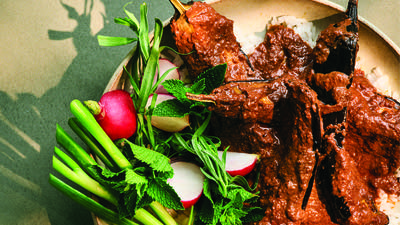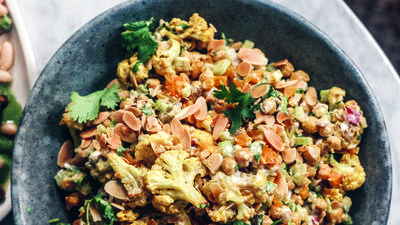
There's a fairly new, award-winning food publication on the scene. Gather Journal is a bi-annual, recipe-driven food magazine devoted to cooking, eating and the art of bringing people together. The photography is hauntingly beautiful; the stories intriguing and insightful. Like a meal, each issue is divided into chapters -- amuse-bouche and cocktails, starters, mains and desserts. Each issue is driven by a theme, and includes special features.
The spring/summer 2013 issue, Rough Cut (Summer Film Issue), caught our attention and held it well into October. The Psycho-inspired Slashed Black & Blueberry Pie cover art comes from the "Death Becomes Him" chapter -- an homage of sorts to the great filmmaker and "master of suspense" Alfred Hitchcock. Alia Akkam highlights memorable culinary cameos from 10 of his films, and the chapter is rounded out with five Hitchock-inspired recipes. It felt so perfect for Halloween, and Gather Journal generously shared a bit of it with us.
- Jennifer Russell
Deep Dishes
Hitchcock was a gourmand--and glutton--and that affinity for food found its way into his films. Here, ten memorable culinary cameos.
1. Rebecca, 1940
 Recipe: Slashed Black & Blueberry Pie
Recipe: Slashed Black & Blueberry Pie
The second Mrs. de Winter remains nameless throughout the film, amplifying how powerless she is against the ghost of Rebecca, the original Mrs. de Winter. When the couple sits down to their first dinner, across a big, formal table in the haunting Manderley estate, it symbolizes the deep chasm between the newlyweds. Rebecca, casting a shadow over the marriage, is present, an unwanted visitor.
2. Shadow of a Doubt, 1943
What is served during this film noir's finely wrought dinner scene is far less important than what is revealed. When Uncle Charlie icily declares his hatred of rich widows during the meal, describing them as "horrible, faded, fat, greedy women," it kicks off a bizarre dinner conversation. A slow burn of mounting clues that eventually convinces the niece that her uncle is in fact wanted serial killer, the Merry Widow Murderer.
3. Notorious, 1946
In the midst of an epically long kiss on a Rio balcony, Alicia, daughter of a convicted Nazi spy, tells government agent T.R. it's too beautiful to leave for dinner. "But you don't like to cook he replies." "No, I don't," she confesses between nuzzling, "but I have a chicken in the icebox and you're eating it," joking the lovebirds may need to use their hands. In this "very strange love affair," food is foreplay.
4. Rope, 1948
At friends Brandon and Philip's dinner party the buffet is spread out on an old chest in the living room. None of the guests are aware, as they reach for the paté that brazenly tucked inside the chest is the body of David, the young men's former classmate, who they strangled. In this apartment, with panoramic New York views, murder is another privilege of the elite, feasting atop a corpse, a sheer thrill.
5. Rear Window, 1954
His leg in a cast, L.B. Jeffries, watches his neighbors' banal lives pass through a window. In one tender moment: a dolled-up woman sets a table for a mythical dinner for two, with candles and air kisses. This bittersweet vignette is juxtaposed with Jeffries' own culinary fate: pristine lobster and French fries from New York's fabled 21 Club, an unheard-of luxury, delivered by his socialite girlfriend. "It's perfect, as always," says an agitated Jeffries.

6. To Catch a Thief, 1955
The French Riviera is the setting for glorious food. Retired cat burglar John Robie serves Quiche Lorraine to an insurance adjustor--"You'll enjoy this," he says, heaping a slab on his plate-- who describes the crust light as air. Then Robie and Frances halt a scenic drive to tuck into fried chicken. Would he fancy a leg or a breast, she asks? An innocent meal, but an intimate one.
7. The Man Who Knew Too Much, 1956
At dinner while on vacation in Marrakech, married couple Dr. and Mrs. McKenna from Indianapolis, dig into chicken served in a mammoth tagine pot. Dr. McKenna asks nervously, confounded by the accompanying puffy bread, "Does it chew better than it tears?" He then is warned to eat with two fingers--only from the left hand, never right--"It's messy but worth it."
8. Vertigo, 1958
James Stewart and Kim Novak may be the stars, but Ernie's, the now-shuttered, once venerable San Francisco restaurant is just as important a character. What meals are consumed here we do not know, only that it is where Stewart first lays eyes on the voluptuous Novak, where he imagines her, and where he brings her "doppelgänger" for dinner. At the end of the film, just before Novak's Judy Barton clasps her telltale ruby necklace, it is a steak at Ernie's she craves.
9. Psycho, 1960
There is a diner ten miles away, but Marion Crane, who just checked into the Bates Motel, does not go. Instead, she is charmed by the awkward Bates' invitation for a humble dinner of sandwiches and milk. "I don't set a fancy table, but the kitchen's awful homey," he says. After Crane overhears a shouting match between Bates and his mother, he comes back with a tray and suggests they dine in the parlor instead. "You eat like a bird," Bates tells her as she takes demure bites of bread. It would be her last supper.
10. Frenzy, 1972
All Chief Inspector Oxford wants is a steak and potato, but instead he must endure the failed culinary experiments inspired by his wife's course at the Continental School of Gourmet Cooking--pig foot smothered in a French sauce for tripe, a soupe de poisson bubbling with aquatic creatures. It adds a layer of dark humor to a plot about a wrongly accused strangler, just like images of vibrant apples and zucchini in the market scenes are juxtaposed with menace. 
Before you go...
Each week, The Splendid Table brings you stories that expand your world view, inspire you to try something new, and show how food connects us all. We rely on your generous support. For as little as $5 a month, you can have a lasting impact on The Splendid Table. And, when you donate, you’ll join a community of like-minded individuals who love good food, good conversation, and kitchen companionship. Show your love for The Splendid Table with a gift today.
Thank you for your support.
Donate today for as little as $5.00 a month. Your gift only takes a few minutes and has a lasting impact on The Splendid Table and you'll be welcomed into The Splendid Table Co-op.



